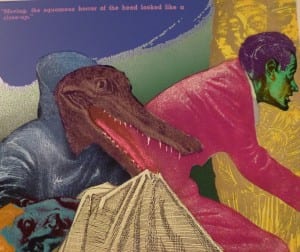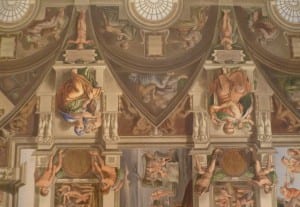Reflections on the Printing Techniques Workshop
By ucwchrc, on 6 June 2014
Slade students, artists and curious print-making novices both from within and outside of UCL got together for a Pop Up lunch-time talk by artist and UCL Art Museum Curatorial Assistant, Ling Chiu on 27th May in the UCL Art Museum. When she is not at the Museum, Ling works at a printmaking studio in southeast London, helping artists such as Ray Richardson and Peter Blake to create prints in screenprint, etching and lithography.
Ling introduced us to fine art printing techniques, referring to the UCL Art Museum’s extensive collection of prints as inspirational examples. We were encouraged to look at a diverse selection before the workshop started, and then to reflect on them again after we had learnt about some of the printing techniques. This produced different engagements with the work, and was a fun way of relating techniques back to the art objects. The most popular print Ling displayed from the collection was Jack Miller’s ‘Weird Tales’ (UCL Art Museum 9239), which had a textured, velvet effect produced by combining flocking with screenprint techniques (think Andy Warhol meets 18th century floral wallpaper!).
The workshop followed on from an earlier session Ling had taken at the UCL Art Museum that looked at traditional printing methods typically used before 1850. This included relief printing (where the ink sits on top of the printing surface, and by which woodcuts and linocuts are made), intaglio printing (where the ink sits inside the printing plate, and is used to produce etchings and dry points), and planograph printing (which involves a chemical rather than physical change, and is used for lithography and screen-printing). With planographs, Ling used examples of her own work and some from the UCL Art Museum collection to describe how you work directly on the surface of the printing plate. You are also able to work on a large scale and in lots of colour as this is a painterly method of printing. However, each colour is drawn on a different stone, making the process relatively complex. One of Ling’s examples, Ludwig Grüner’s Sistine Chapel (UCL Art Museum 2872), took about 11 stones to achieve the subtle and extensive range of colours!
Not all of us had attended the first session on traditional prints, but this didn’t seem to matter, partly because Ling was so engaging and gave us a little explanation about these processes. Also this second workshop focused on more recent printing methods, and those inspired by photography or using photographic techniques.
Although I’ve often felt that the different printing techniques seem quite complicated and sometimes hard to visualise, Ling really helped to change this assumption by providing an easy-to-understand introduction to methods such as mezzotints and aquatints. Both these techniques produce soft tones on copperplates. In contrast, screenprinting produces a flat effect. It is, however, very diverse as you don’t need the pressure of a press to make it. This means you don’t need to print on paper but can use a wide range of media including textiles, wood and glass. Ling’s discussion of these contrasting techniques revealed just how much creative, experimental freedom could be found in printmaking.
The most intriguing photo-printing method we looked at was photopolymer. It can also be called solar-plate printing, or heliogravure! This new printmaking technique needs only the plate, sunlight and water, making it accessible to everyone. It creates relief prints without cutting and is often used for text and to emboss ceramics. However, once it has been exposed to the sun it can’t be hand correct like other methods as it is physically harder than steel!
Ling demonstrated and talked us through many intriguing details about printmaking. By the end of the session I think we all had a greater understanding into the world of prints, and many of us had eagerly made note of places to go and experiment with these techniques as well as being keen to further explore the prints at the UCL Art Museum. It was certainly a great workshop to be held in the UCL Art Museum because the largest part of its collection is prints, and this allowed us to be fully immersed in the subject.
Helen Cobby is a volunteer at UCL Art Museum and an MA History of Art student at UCL
2 Responses to “Reflections on the Printing Techniques Workshop”
- 1
-
2
Reflections on UCL’s Printing Techniques Workshop | Helen Cobby wrote on 2 July 2014:

[…] This article is published on the UCL Art Museum blog […]
 Close
Close




[…] printing is an old and widely utilized printing technique which, today, is typically used for t-shirt printing. The procedure entails transferring an image […]